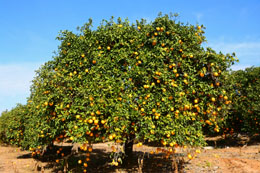Citrus trees are often left to grow in the wild without being taken care of, as they are considered fit enough to grow on their own. Read the following article to know why pruning them is necessary to ensure proper growth.

A citrus tree has a very hard bark and it grows in a manner that it can grow perfectly well in the wild. Thus, many people who own trees, think that not pruning it, and only watering it, will yield a better fruit, but they are often wrong. Pruning citrus trees is as important as planting them, as they need to be maintained and taken care of, if you want a better quality fruit. It is not a very difficult job to prune a citrus tree, as you have to follow the same instructions applicable for any other deciduous tree. Of course, you will need some very effective and sharp pruning tools and a lot of time to do so, as this task takes effort and energy.
Pruning Requirements, Technique, and Steps
Almost all trees, except the lemon trees, require pruning only once in every two years. It is basically needed to make them look good, healthy, and within bounds. Pruning also helps in preventing the trees from getting diseased, produce better sized, tasty, and well shaped citrus fruits, and also look great. You can prune the trees anytime between March and August, but the best time to do it is before the trees start flowering early during the year. Even though the other trees need less, lemon trees need to be pruned more frequently to keep them in bounds, so fruit picking is easy. These also grow faster than the other citrus species, thus, they need to be pruned more often.
Step 1
You have to be sure of the right time to prune your tree, preferably before the trees start to flower. If you have planted the tree, you should know the period and intensity of the growth.
Step 2
You should preferably prune the mature trees, as they need to be cleaned of their dead and rotten branches. Any of the limbs or branches which are crisscross and growing in a wavy manner, should also be removed, as they make the tree look unbound and shabby.
Step 3
While pruning, remove the sprouts which you are sure will grow out large and uneven. If these sprouts grow large, pruning these branches becomes more difficult and requires more effort. Do not prune trees after May, as they will not grow for another year.
Step 4
Make sure, the bark of the pruned tree is not exposed to the sun, if it is, cover it with whitewash or latex paint.
Step 5
If the bark or branches of the tree are infected, you can get rid of it either by cutting these branches or by peeling the affected area of the bark. Many fungal growths and parasites which grow on trees can also be removed by pruning. This will maintain the quality of the wood.
Step 6
Termites are the worst enemies of trees and should be protected from them. At such times, make sure you remove the foundations of the termites and medicate the tree to keep it away from further damage.
Step 7
Next, water them well, and let them grow for another one year without cutting or trimming them.
With these tips and techniques, the yields of these trees are sure to be very good. And your trees will also look lush green and very healthy.






 A citrus tree has a very hard bark and it grows in a manner that it can grow perfectly well in the wild. Thus, many people who own trees, think that not pruning it, and only watering it, will yield a better fruit, but they are often wrong. Pruning citrus trees is as important as planting them, as they need to be maintained and taken care of, if you want a better quality fruit. It is not a very difficult job to prune a citrus tree, as you have to follow the same instructions applicable for any other deciduous tree. Of course, you will need some very effective and sharp pruning tools and a lot of time to do so, as this task takes effort and energy.
A citrus tree has a very hard bark and it grows in a manner that it can grow perfectly well in the wild. Thus, many people who own trees, think that not pruning it, and only watering it, will yield a better fruit, but they are often wrong. Pruning citrus trees is as important as planting them, as they need to be maintained and taken care of, if you want a better quality fruit. It is not a very difficult job to prune a citrus tree, as you have to follow the same instructions applicable for any other deciduous tree. Of course, you will need some very effective and sharp pruning tools and a lot of time to do so, as this task takes effort and energy.